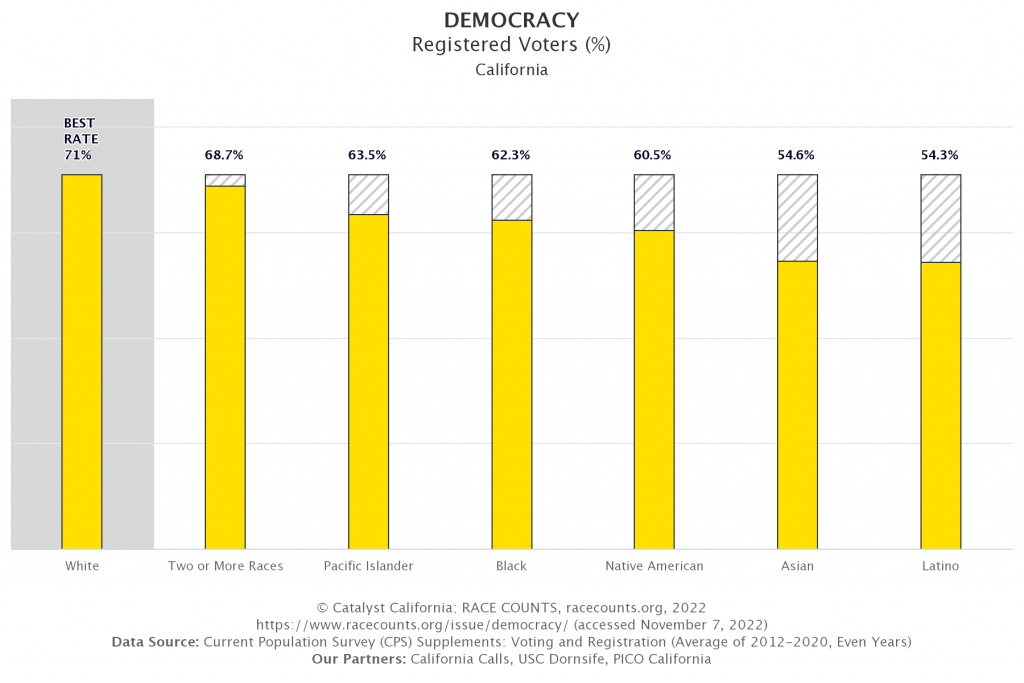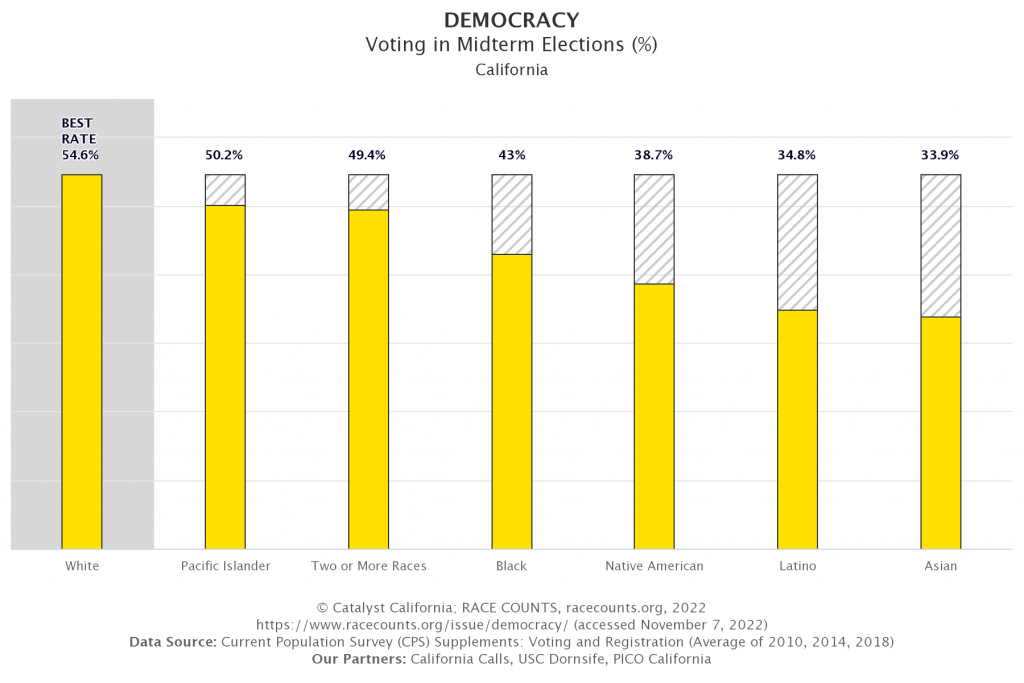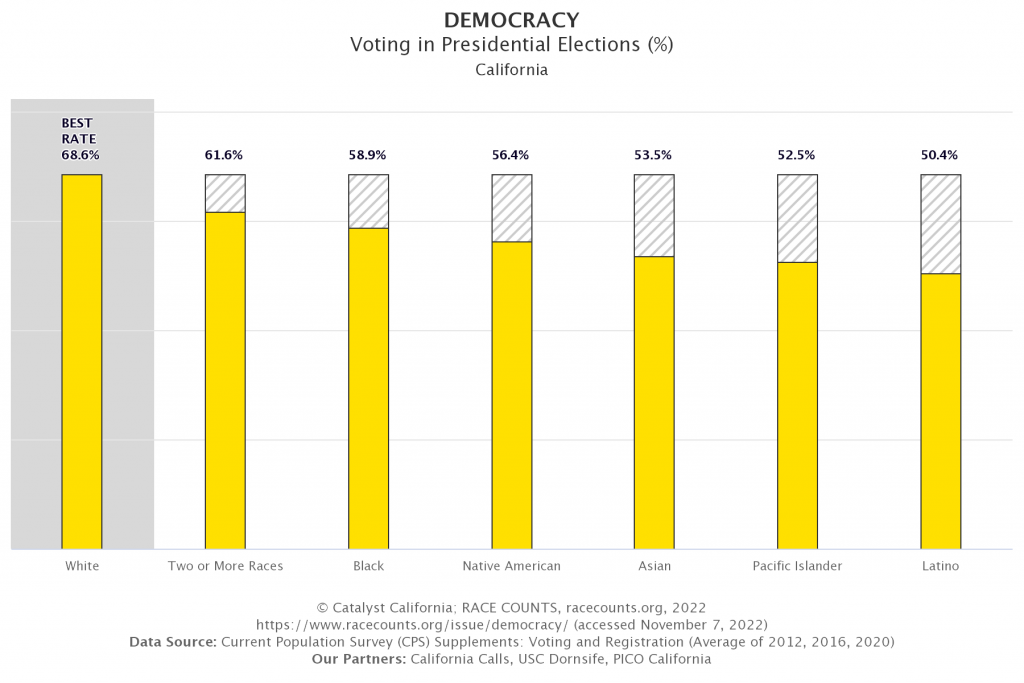Ahead of tomorrow’s election, RACE COUNTS is releasing updated data behind four of the six Democracy indicators and the overall Democracy Index. Here are key findings for voter registration and voter turnout, as well as an analysis of the factors impacting these indicators and a discussion of potential policies that can reduce racial disparities in democratic participation.
Key Findings
Registered Voters

Across California, RACE COUNTS’ data finds that Latinx, Asian, American Indian and Alaskan Native, and Black voter registration rates fall below the state average. Fresno County voter registration rates are the lowest and most disparate among California counties. Fresno has lower-than-average outcomes on nearly all Democracy indicators and, as a result, it has the second worst outcomes on the Democracy Index statewide.
Presidential and Mid-term Election Voting


At the state level, we see that Latinx, Pacific Islander, Asian, American Indian and Alaskan Native, and Black Californians have presidential voter turnout rates lower than the state average. Similar disparities exist for midterm elections, with Asian, Latinx, American Indian and Alaskan Native, and Black Californians having lower voter turnout rates than the state average. Statewide, we find that Tulare County and Imperial County have the lowest presidential and midterm voter turnout rates, respectively. Data also shows that Stanislaus County and Tulare County have the highest disparity in presidential and midterm voter turnout rates, respectively.
Root Causes
Historical discrimination
People of color, and Black people in particular, have faced a long history of systemic discrimination in participating in our democracy. While the 15th Amendment extended the franchise to men of all races, people of color continued to experience significant barriers to voting including poll taxes, literacy tests, and the “grandfather clause.” Beyond these institutional barriers, people of color also faced voter suppression efforts that included extra-judicial campaigns of violence and intimidation led by organized paramilitary groups.
Lack of Trust
One factor that is associated with participation in democracy is trust in government, as individuals who trust the government re more likely to turn out to vote.1 Given historical discrimination and contemporary inequities, people of color often distrust government institutions. Law enforcement, for example, are some of the most commonly encountered government representatives, and well documented racial inequities in police violence is a major contributing factor to lack of trust in government.
Lack of Contact
Community-based organizations, candidates, and political parties often directly contact individuals to promote democratic participation. Research finds that this direct contact is effective as it is associated with increased likelihood of voting.2 However, research also finds that there are racial inequities in direct contact. In 2016, less than half of Black eligible voters received direct contact from partisan or non-partisan organizations and Asian American, Latinx, and Native Hawaiian and Pacific Islander eligible voters were contacted at a rate lower than White potential voters.3
Potential Policy Solutions
Remove registration and voting barriers
California has enacted several policies designed to make it easier to vote. These policies include automatic voter registration when receiving a driver’s license, and universal vote by mail. It is important to monitor the impact of these policies to track whether they inadvertently expand inequities. For example, researchers have found that Black voters are less likely to have a driver’s license due to low incomes and lack of a vehicle. So, while policies like ‘motor voter’ can increase registration, they may disproportionately benefit people with higher incomes and vehicle owners, who are more likely to be White. Changes to in-person voting, including the consolidation of polling places, also exacerbated inequities by expanding voter turnout gaps among Black and Latinx registered voters.4
Further effort is needed to remove barriers to participating in the democratic process that Californians of color face. One potential area worth pursuing is improving the in-jail voting system, as individuals who are involved in the criminal legal system are disproportionately people of color5 who face “de-facto disenfranchisement” despite many of these individuals being eligible to register and vote in California.6
Democracy Vouchers
Candidates and political parties are particularly likely to contact and engage with individuals who contribute to campaigns. Research finds that individuals with higher household incomes are more likely to make political donations. Given the racial inequities in income and socioeconomic status more generally, this also means that people of color, compared to their White peers, are less likely to be donors to political campaigns.7 One potential intervention to address these inequities is democracy vouchers. Democracy vouchers are publicly subsidized vouchers that residents can donate to candidates of their choice. Vouchers enable constituents to make campaign contributions regardless of their income or wealth. By leveling the playing field on campaign contributions, candidates would have a greater incentive to contact and engage with communities of color – rather than prioritizing more affluent, White campaign donors. This increase in contact and engagement may have downstream impacts on voter turnout. Seattle, which recently enacted a democracy voucher program, saw an increase in voter turnout, particularly among those less likely to vote.
Participatory Budgeting
Voting is not, and should not be, the only way to make our democracy more responsive to our communities. One innovative way to increase democratic participation is through participatory budgeting. Participatory budgeting gives residents power over public money to fund projects that will make a difference in their lives. In general, participatory budgeting is a democratic process in which community members inform budget allocations to decide the best use of public resources.8 Participatory budgeting opens up avenues for democratic participation beyond elections and can allow individuals who are unable to vote to participate in the democratic process.
The participatory budgeting process often brings community members into direct connection with elected officials and public administrators, which helps to build and strengthen relationships. Participatory budgeting offers a potential opportunity for vastly improving the influence Californians of color have on government resource-allocation decisions while deepening democracy beyond the normal electoral process, improving trust in government, and creating meaningful contact between residents of color and their elected officials.
Take Action
For more information about voting in tomorrow’s election, including resources on where to find your local polling place, visit vote.ca.gov.
- https://blogs.lse.ac.uk/politicsandpolicy/political-trust-meta-analysis/ ↩︎
- Maxwell, Connor. “5 Ways to Increase Voter Turnout in African American Communities.” Center for American Progress, July 18, 2018. https://www.americanprogress.org/article/5-ways-increase-voter-turnout-african-american-communities/. ↩︎
- Ramakrishnan, Karthick, Janelle Wong, Jennifer Lee, and Taeku Lee. Rep. 2016 Post-Election National Asian American Survey, May 16, 2017. http://naasurvey.com/wp-content/uploads/2017/05/NAAS16-post-election-report.pdf. ↩︎
- https://www.ppic.org/publication/equity-in-voter-turnout-after-pandemic-election-policy-changes/ ↩︎
- Public Policy Institute of California, California’s Prison Population, Joseph Hayes, Justin Goss, Heather Harris, and Alexandria Gumbs, https://www.ppic.org/publication/californias-prison-population/. ↩︎
- “Voting Rights: Persons with a Criminal History.” Voting Rights: Persons with a Criminal History. California Secretary of State. Accessed September 2, 2022. https://www.sos.ca.gov/elections/voting-resources/voting-california/who-can-vote-california/voting-rights-californians. ↩︎
- https://www.washingtonpost.com/news/wonk/wp/2014/12/15/why-big-spending-on-political-campaigns-makes-racial-inequality-worse/ ↩︎
- “What Is P.B.?” Participatory Budgeting Project, July 17, 2020. https://www.participatorybudgeting.org/what-is-pb/. ↩︎